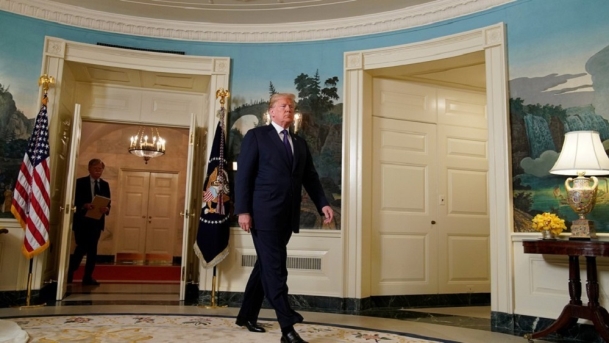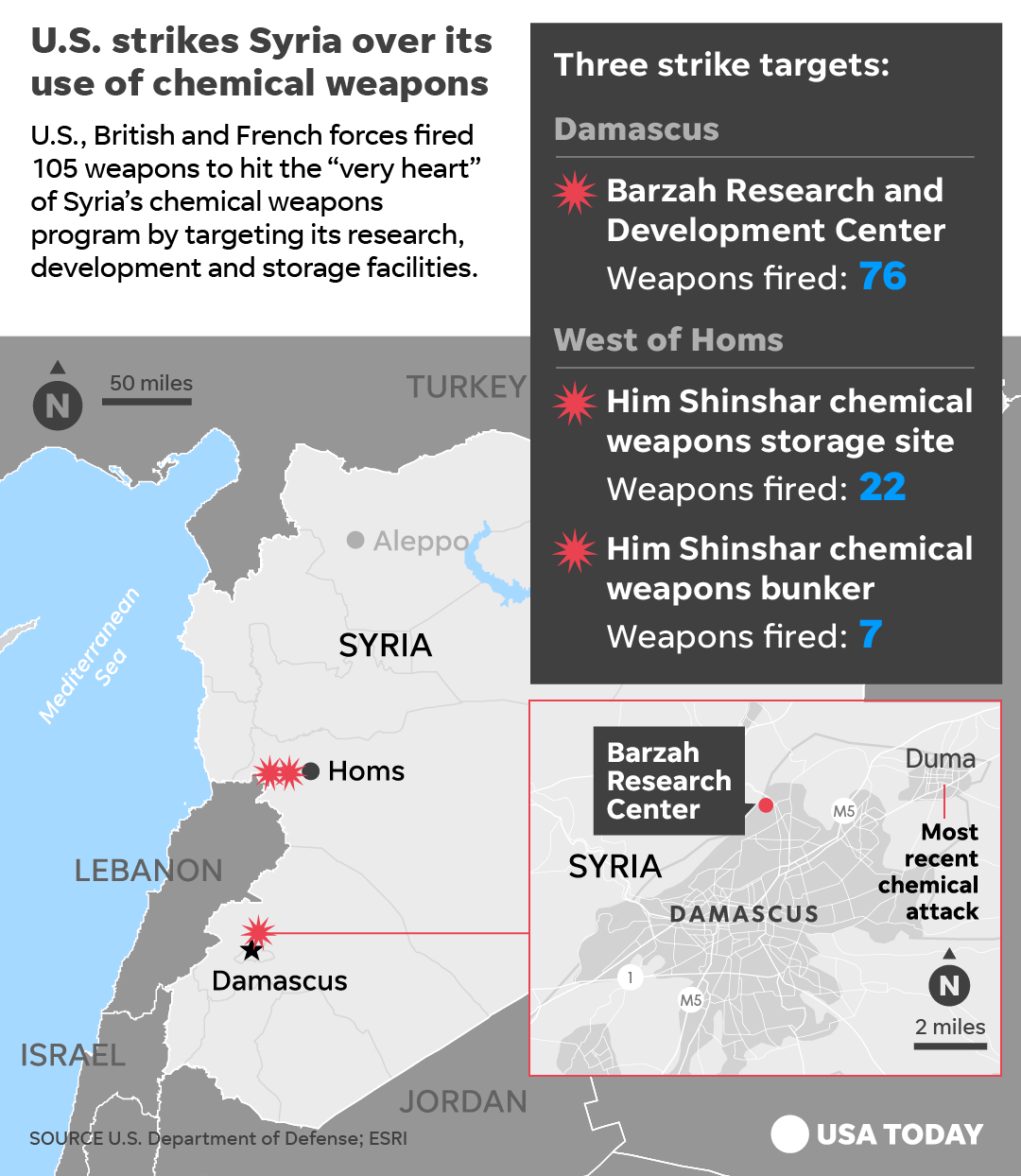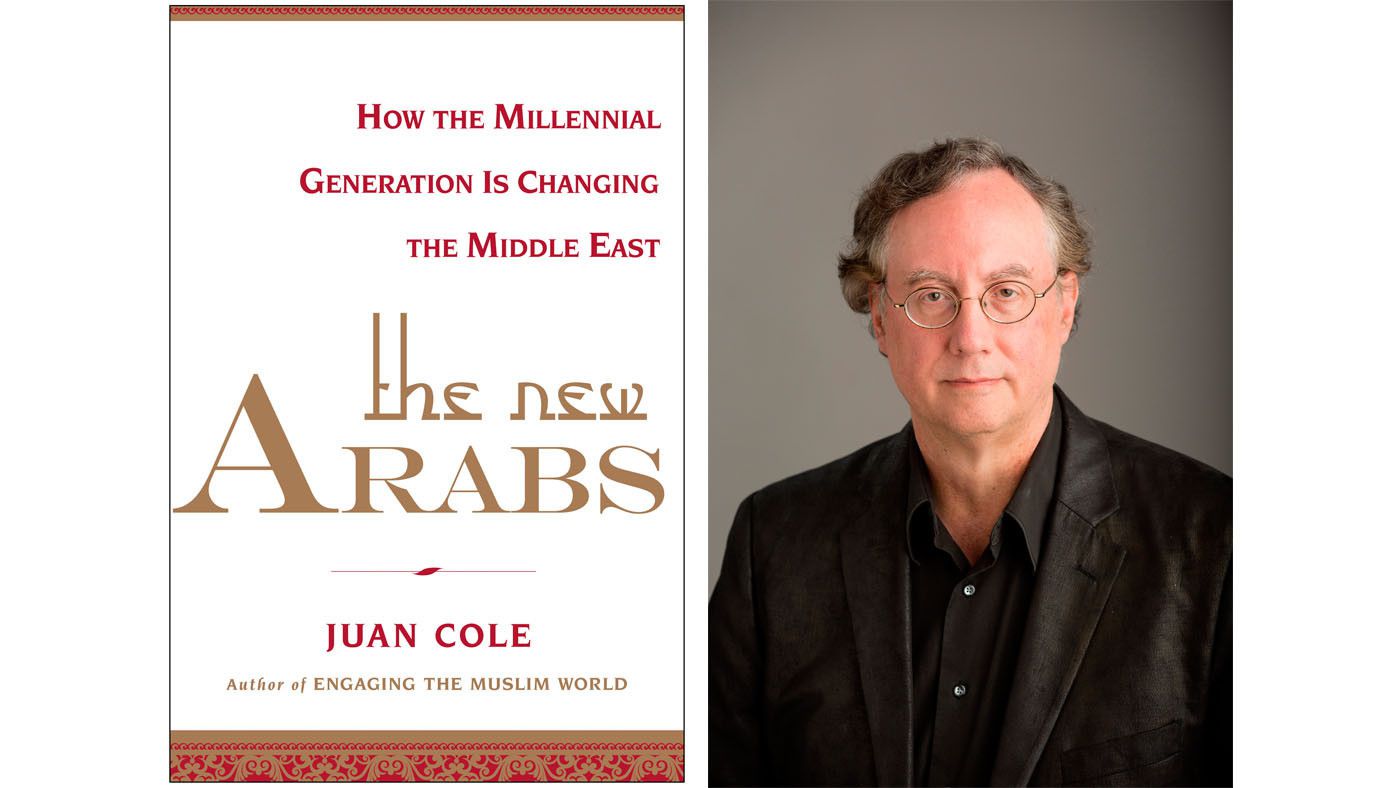
The Trump administration has been divided with regard to grand strategy in the Middle East. Trump himself appears to favor a U.S. retrenchment from the region and a deployment of offshore balancing, the use of regional proxies or setting enemies against one another. In contrast, his cabinet has often been committed to U.S. global primacy. Trump’s inexperience in the region has led him into a series of debacles, including the decision to move the US embassy to Jerusalem, which alienated the Palestinians and much of the Muslim world. With regard to the crisis in the Gulf Cooperation Council and the blockade of Qatar, Trump enthusiastically piled on at his Twitter account. He was later persuaded to seek negotiations among the former partners in the Gulf, but questions remain whether the United States can recreate a united front against Iran in that region. Trump and his Secretary of Defense James Mattis pursued an “annihilation” policy against ISIL in Iraq, producing high civilian casualties in campaigns such as the bombardment of Mosul in spring-summer 2017, raising questions about whether the Iraqi government can succeed in reincorporating Sunni Arab populations in the aftermath of the defeat of ISIL. In Syria, Trump during his first year continued the Obama policy of allying with the YPG Kurdish militia against ISIL, defeating it in Raqqa in October of 2017. His pivot in April of 2018 to planning for a subsequent U.S. withdrawal from that country, in essence turning it over to Russia, startled Washington and the Kurds.
The primary regions of the Middle East in which President Donald J. Trump has taken an interest since being sworn into office on January 20, 2017, are Iraq, Syria, the Gulf and Israel-Palestine. In each arena, Trump has committed diplomatic faux pas, made outlandish statements, and reversed himself on several occasions, making it difficult to descry any policy coherence. In general, Trump appears to favor dependence on friendly regional and global strongmen as his primary tool of diplomacy. This preference has created situations in which candidates for the role have heavily lobbied him for it and sought to sideline rivals and even potential partners in this balancing.
U.S. foreign policy since World War II had often been based on a willingness to intervene directly in the governance of other countries and to site large bases abroad, sometimes even offering an ally a nuclear umbrella. The U.S. in South Korea, Japan, some NATO states, Afghanistan from 2001, and Iraq 2003-2011 and again from 2014 fit this profile of global primacy. Motives differed for these interventions, some aiming to block enemies such as the Soviet Union while others aimed at securing resources or spreading liberal, democratic values. This strategy can be expensive, and can result in failures when it meets local resistance (as in Vietnam, Iran and Iraq).(1) Trump, like many in the American public, has wearied of this attempt at global primacy and objects to it on the grounds that America’s role as international policeman (with barracks around the world) benefits its partners and protects them from enemies, but that they typically do not reimburse the U.S. for its costs.(2)
The other possible way for a Great Power in the twenty-first century to assert itself and its interests involves finding a local proxy willing to act regionally to exclude US enemies and uphold its allies. This approach has been termed “offshore balancing.” John Mearsheimer and Stephen Walt have advocated that the U.S. farm out security to proxies where possible, intervening only when partners prove weak. They urge that Russia be allowed to deal with Syria, where the U.S. has no obvious interests other than the defeat of ISIL extremism.(3) Trump tends to favor a nationalist version of this approach in his rhetoric, although he has not always implemented practical changes.
Jerusalem
The most dramatic policy change initiated by the Trump administration in the region was the president’s announcement in December 2017, allegedly at the behest of casino mogul and Republican donor Sheldon Adelson, that he would move the U.S. embassy to Jerusalem, de facto recognizing that city as the capital of Israel. Jerusalem is considered by the rest of the international community an issue to be resolved in final status negotiations between Israel and the Palestine Authority. Trump’s announcement soured Palestinian president Mahmoud Abbas on the administration. He announced that he would not accept the U.S. as an honest broker in any future negotiations. Some Palestinian politicians called for rescinding the recognition of Israel and withdrawing from the Oslo Accords. An angry Trump riposted by slashing U.S. contributions to the United Nations Relief and Works Agency (which cares for millions of Palestinian refugees) and with threats to cut the Palestine Authority off from American aid. When the UN General Assembly overwhelmingly condemned the decision, Trump threatened a cut-off of aid to those countries as well. The potential of the embassy move to spark protests and even terrorism against the U.S. throughout the Muslim world has been ignored in Washington.(4)
In the run-up to the implementation of the embassy move and the 70th anniversary of the founding of Israel, in spring 2018, Palestinians in Gaza staged a series of rallies near the border with Israel demanding the right of return (some 70 percent of Gaza residents are from families made refugees in 1948, whose homes in what is now Israel were confiscated). The Israeli government, apparently confident that President Trump would not object, adopted a policy of having its troops use live ammunition to fire into the assembled crowd, killing nearly two dozen in the first two weeks and wounding hundreds.(5)
Trump’s unilateral and hard line support for Israeli territorial claims over those of Palestine and his blocking of any condemnation at the UN security council of the Israeli sniping at unarmed protesters, set the stage for what appears to be a new phase of Palestinian activism and unrest. With the alienation of the Palestine Authority and especially of the Palestine Liberation Organization faction, the U.S. has lost some influence in the Levant.
Qatar Crisis
In spring of 2017, only a few months into his presidency, Trump traveled to Riyadh for a summit on counter-terrorism, which saw the founding of a center to fight terrorism in Saudi Arabia.(6) His son-in-law, Jared Kushner, is said to have bonded on this trip with Saudi crown prince Mohammed bin Salman Al Saud, 32, widely considered the power behind the throne. Perhaps assured by their new relationships in Washington, the United Arab Emirates and Saudi Arabia went on to launch a plot against Qatar. They manipulated video of a speech by Qatari Emir Tamim bin Hamad Al Thani to make it appear that he was attacking Saudi Arabia. On June 5, 2017, Riyadh and Abu Dhabi announced an air blockade and wide-ranging boycott. Some reporting alleges that crown prince Mohammed Bin Zayed Al Nahayan of Abu Dhabi and Mohammed bin Salman considered a military invasion and the placing of a pretender on the Qatar throne.
This move on Qatar was initially greeted enthusiastically by Trump, who tweeted that Qatar had been a major source of terrorism and that he hoped that this pressure would bring an end to the problem. The president appears to have been unaware that Qatar had for many years hosted a major U.S. air base at al-Udeid, from which most of the U.S. strikes on ISIL and other radicals in Afghanistan and Iraq were flown.(7)
The UAE and Saudi ultimatum, joined by Bahrain and Egypt, demanded that Qatar cease supporting the Muslim Brotherhood and close its Al Jazeera satellite television channel. The Saudi and UAE charges were a farrago of falsehoods and half-truths, and the ultimatum in effect demanded the surrender of Qatari sovereignty. The two were made to back off aggressive intentions in part by strong Turkish intervention. Qatar’s merely correct relationship with Iran warmed considerably, and Iranian produce flooded into the country.
Secretary of Defense James Mattis and then Secretary of State Rex Tillerson had both had long experience in the Gulf and knew the positive role Qatar had played as a partner in Washington’s war on terrorism. Over time, they appear to have convinced Trump to adopt a more neutral stance.(8) In spring of 2018, the White House hosted in turn visits by Mohammed bin Salman and Qatari emir Tamim bin Hamad Al Thani. A bigger summit was planned for September of 2018. The general impression of the U.S. press at the time of Tamim bin Hamad’s visit was that a Qatari “charm offensive” had turned things around in Washington, resulting in a determination by Trump and his team to resolve the crisis.(9)
Trump’s initial response in June of 2017 gave Iran an opening to expand relations with Qatar and be seen in Doha as a lifeline. While Qatar strove in the aftermath to make a stronger case for itself to Washington’s movers and shakers, it will almost certainly attempt to diversify its foreign policy in the aftermath. The al-Udeid base will be expanded, but a Turkish military installation will be added. Trump’s lack of knowledge of the region and tendency to be easily led by the nose when flattered, along with his tendency to shoot from the hip on Twitter, certainly weakened the U.S. position in the Gulf, to Iran’s advantage.
Iraq
On the campaign trail, Trump’s positions on Iraq ranged widely. He maintained that he had opposed the Iraq War in 2003, though journalists found evidence that his position had been more ambiguous than that, at least initially. He alleged, however, that once it did invade and occupy Iraq, the U.S. should have insisted on being richly rewarded for it, and should have “taken Iraqi oil.” He called for carpet-bombing of the so-called Islamic State group or the “Islamic State of Iraq and the Levant” (ISIL), which then still controlled Mosul and other parts of northern Iraq. He also called for kidnapping and menacing the family members of the ISIL leadership.
Once in office, Trump’s Secretary of Defense, James Mattis, continued the strategy developed by the Obama administration for defeating ISIL. The U.S. continued to station some 6,000 troops in Iraq, many of them trainers or special operations forces and sought to build back up the national Iraqi Army, which had collapsed in 2014 when ISIL came to Mosul. Mattis was forced to attempt to soothe ruffled Iraqi feathers over Trump’s assertion of interest in “taking” Iraqi petroleum, attempting to re-assuring the Baghdad political class on this score.
The U.S. played an important role in planning and strategy for the Mosul campaign. The Iran-backed Shiite militias that served as auxiliaries to the weak Iraqi army were persuaded to stay out of the city and to deploy to its west and north to cut off escape routes for ISIL fighters. The biggest difference between Obama and Trump tactics appears to have been a loosening of the rules of engagement for aerial bombardment, such that concerns about hitting civilian apartment buildings and other non-combatant infrastructure were set aside. As a result, noncombatant casualties rose significantly.(10) After the July, 2017, fall of the city to the Iraqi army, the ferocious character of the campaign made it more difficult for the Iraqi government in Baghdad to reestablish its legitimacy in the aftermath in the mostly Sunni Arab north.
At a fundraising conference for Iraq reconstruction in Kuwait in February 2018, the Trump administration caused a stir by refusing to contribute. It was reported that the U.S. hope was that Saudi Arabia would make a big donation and woo Baghdad away from its Iran entanglements.(11) If Trump administration officials did entertain these hopes, they were not founded on any expertise in the political and economic realities of the region, and they of course proved entirely baseless.
By spring of 2018, with ISIL defeated as a territorial government, the victorious Baghdad government moved to regularize the Shiite militias by recognizing them in law and giving their commanders formal military ranks. Given that several of these Shiite militia commanders had demanded that U.S. troops leave Iraq after the defeat of ISIL, the American press saw these moves by Prime Minister Haidar al-Abadi as signaling a tilt toward Iran in the post-ISIL period.(12) The prominence of the militias and parties they backed in the parliamentary elections of May 12 2018 further raised question marks about the shape of the parliament going forward and the possibility that powerful elements of it might be hostile to the presence of the U.S. military.(13) With the Trump administration refusing to help Iraq reconstruction, tilting heavily to Saudi Arabia (which many Iraqis view with suspicion), and hostile to Iran, trade and relations with which is essential to the Iraqi government, the future of U.S.-Iraqi relations remain murky.
Syria
Syria on the surface might seem to have been tailor-made for the implementation of Trumpian offshore balancing. Trump prefers strongmen such as al-Assad, though he has strongly condemned the latter’s use of chemical weapons. The Russian Federation wants Syria as a sphere of influence. Since Trump sees Russia as a partner in fighting Muslim radicalism and terrorism (which he views as his country’s major foreign policy challenge), he has repeatedly stated a willingness to let Moscow handle the Syria crisis.
During his first year in office, however, Trump acquiesced to the wishes of the Pentagon and kept in place the old Obama administration’s approach to the so-called Islamic State group or the “Islamic State of Iraq and the Levant” (ISIL). After the fall of Mosul in 2014 on the Iraq side of the border and the attacks on Paris in 2015, the Obama administration was abruptly frantic to defeat ISIL. Obama was willing to provide air power, as were NATO allies, but needed ground forces willing and able to take territory in hard fighting.
The one ground force Obama was able to enlist was the paramilitary of the Syrian Kurdish Democratic Union Party, the “People’s Protection Units” (YPG). The Syrian Kurds were menaced by concerted attacks by ISIL, which took the Kurdish enclave of Kobane and which sought to expand its territory to the northeast into the Jazira. Over time several hundred U.S. special operations forces were embedded with the YPG militia, and they defeated ISIL in Kobane with U.S. air support before going on to take the town of Manbij.
On taking office, Trump benefited from this forward momentum and from the Obama strategy, and he allowed it to go forward. By October of 2017, the YPG had captured Raqqa after extremely hard fighting, with U.S. and allied fighter jets levelling much of the city. In the subsequent months, the U.S. and the YPG fought down into the province of Deir al-Zor, in a race with Russian-backed Syrian Arab Army troops to take that eastern province entirely away from ISIL.
At the Hoover Institution on January 17, 2018, then-Secretary of State Rex Tillerson outlined U.S. goals in Syria. These included the enduring defeat of ISIL and al-Qaeda, the resolution of the Syrian Civil War through negotiations and a post-Assad leadership, the diminution of Iranian influence in Syria, the return of Syrian refugees and internally displaced persons, and the removal of all chemical weapons from Syria.(14) These goals represented the liberal primacy aspirations of the Washington establishment rather than Trump’s own preference for offshore balancing.
Tillerson also attempted to reassure the Turkish government, which had become extremely alarmed by reported Pentagon plans to train a 50,000-man Kurdish border police.(15) His attempt at mollifying Ankara, however, failed. The contradictions in the policy of allying with post-Communist Kurds in northern Syria became especially vivid in spring of 2018. Turkish president Recep Tayyip Erdogan intervened militarily from February of 2018 to attempt to derail it. He sent in the Turkish Army, assisted by Arab fundamentalist rebels of the Free Syrian Army, to take the town of Afrin, the westernmost Kurdish Syrian enclave. The YPG fighters were enraged that the U.S. did nothing to oppose the Turkish invasion. Many deserted the clean-up operations against ISIL to go support the YPG in Afrin, to no avail. Turkey prepared to move east to Manbij, which the U.S. had encouraged the YPG to take, and where there were embedded U.S. special operations forces.
In the meantime, the Syrian regime and its Russian backers took advantage of the Trump administration’s lack of interest in human rights issues and the rebels’ acceptance of “de-escalation zones” to conquer the last major rebel position near the capital, East Ghouta, in March-April 2018, with fighters and thousands of inhabitants allowed to move north to Idlib.
By early April of 2018, Trump began speaking of ISIL as having been decisively defeated. He pushed his National Security Council aids and the Department of Defense on the need for a U.S. withdrawal from Syria. He froze $200 million in reconstruction funds for eastern Syria. Secretary of Defense James Mattis appears to have been able to prevail on Trump to delay the U.S. withdrawal until October 2018, just before the congressional midterms, to give the mop-up operations against ISIL time to succeed decisively.(16)
A hiccough in this plan for disengagement from Syria took place on April 7, when the Syrian regime allegedly deployed a mixture of chlorine and sarin gas against the Douma enclave of East Ghouta, frustrated by Saudi-backed Army of Islam holdouts. The strike killed dozens of civilians and determined Trump to hit Syria again. It is not clear, however, that any such bombardment would be more than symbolic or that Trump had changed his mind about withdrawing.
At the time of writing, Trump seemed set to implement offshore balancing in Syria, letting Russia and the Baath state take care of ISIL remnants in east Syria. This plan had the advantage of significantly reducing tensions with both Moscow and Ankara. The disadvantages of Trump’s turn to offshore balancing in Syria are significant. The Kurds will certainly conclude that the U.S. used and discarded them, and President Erdogan could pursue further military adventures in Syria that will also roil eastern Anatolia. The defeated and sullen Sunni Arabs of central and northern Syria are unlikely to accept the status quo ante, as al-Assad and Putin appear to believe they will, and Syria will remain fragile. Further upheavals and terrorist tactics coming out of the bleak Syrian landscape could pose sever security risks to U.S. allies.
 |
| [U.S. Department of Defense] [Unspecifeid] |
Conclusion
One problem with offshore balancing as a strategy is that often no consensus exists on which are the enemies and which the partners. Trump, for instance, sees Muslim extremism as an enemy but views the Russian Federation as a potential friend. He will therefore engage in offshore balancing in a manner entirely different from that of politicians who see Putin’s Russia as the primary threat to U.S. interests and who are willing to ally with the Muslim religious Right.
There is the further question about whether to seek a single proxy for offshore balancing or to adopt a multilateral approach. The latter has been ordinary since 1945, such that the U.S. attempted to mobilize both Greece and Turkey against the Soviet Union, despite the severe disagreements between the two. Trump’s instinct is to take sides in regional disputes, build up a major regional power, and then charge it with protecting U.S. interests. For this reason, Trump has disrupted the de facto condominium that existed between Israel and the Palestine Authority with regard to Levantine security. By disregarding entirely Palestinian aspirations and moving the U.S. Embassy to Jerusalem, Trump put all his eggs in the Israel basket and effaced the last vestiges of any American claim to be an honest broker. This move weakened the PLO and emboldened Hamas in Gaza to stage large rallies at the Israeli border. The Israeli government, emboldened by certainty of Trump support, felt able to react by sniping at the unarmed protesters, killing journalists, persons praying, and children, and wounding hundreds with live fire.
Likewise, Trump’s initial willingness to build Saudi Arabia’s Mohammed bin Salman up as the primary U.S. proxy in the Gulf and to join in pillorying Qatar helped to destroy the Gulf Cooperation Council as a security organization and strengthened Iran’s hand in the region. Further, the Trump administration’s apparent hopes of leveraging its Saudi client into a position to perform offshore balancing duties in Iraq overstated the actual power of the Saudis and the unpopularity of their hard line interpretation of Wahhabi Islam, especially for Shiites. These vain hopes in the United States also display a continued blindness to the essential role Iran played in the defeat of ISIL in Iraq and an unwillingness to consider Iran dispassionately as a sometimes useful player in the region for American interests. The hostility to Iran of Trump’s regional proxies, Israel and Saudi Arabia, was one powerful reason for this blindness, though from a foreign policy standpoint this recalcitrance was a matter of the tail wagging the dog.
Trump’s willingness to have Russia play the role of offshore balancer against ISIL in Syria going forward implied an acquiescence in the restoration of the Baath government of President Bashar al-Assad and in the continued influence in that country of Iran, Russia’s ally. Yet Trump’s hostility to al-Assad’s predilection for using chemical weapons to make up for his small army and level the playing field with the larger militias, led to his occasional bombing of that country. Whether he can maintain the focus over time to stick with his Russian ally in Syria, or will be persuaded by the U.S. military-industrial complex to remain in eastern Syria and work on the ground against Iran and al-Assad remains to be seen.

(1) For the failures of U.S. global primacy attempts in the George W. Bush administration with regard to the Middle East see Juan Cole, Engaging the Muslim World (New York: St. Martin, 2009).
(2) Shaohan Lin, “The Public Costs of Grand Strategy in the Trump Era,” World Affairs 179, no. 3 (2016):4-23.
(3) John J. Mearsheimer and Stephen M. Walt, “The Case for Offshore Balancing: A Superior U.S. Grand Strategy,” Foreign Affairs 95, no. 4 (July/August 2016).
(4) Jeremy B White, “Palestinian leaders call on PLO to suspend recognition of Israel in latest fallout from Trump Jerusalem decision,” The Independent, January 15, 2018; Bernard Wasserstein, “Trump’s Jerusalem Embassy Move: A Busted Flush?” Foreign Policy Research Institute, April 2, 2018, https://www.fpri.org/article/2018/04/trumps-jerusalem-embassy-move-a-busted-flush/
(5) “Israel: Gaza Killings Unlawful, Calculated: Officials Green-Light Shooting of Unarmed Demonstrators,” Human Rights Watch, April 4, 2018, https://www.hrw.org/news/2018/04/03/israel-gaza-killings-unlawful-calculated
(6) Dennis Jett, “Trump’s Saudi Arabia speech confirms massive shift in U.S. foreign policy,” The Conversation, May 23, 2017 https://theconversation.com/trumps-saudi-arabia-speech-confirms-massive-shift-in-us-foreign-policy-78168
(7) Dexter Filkins, “A Saudi Prince’s Quest to Remake the Middle East,” The New Yorker, April 9, 2018.
(8) Juan Cole, “David and Goliath: How Qatar Defeated the Saudi and UAE Annexation Plot,” The Nation, February 16, 2018.
(9) Gardiner Harris and Mark Landler, “Qatar Charm Offensive Appears to Have Paid Off, U.S. Officials Say,” New York Times, April 9, 2018.
(10) Murtaza Hussain, “Civilian Casualties Soared in Iraq and Syria in 2017. Was Trump’s Bloodthirsty Rhetoric to Blame?” The Intercept, February 22 2018, https://theintercept.com/2018/02/22/civilian-casualties-soared-in-iraq-…; , Human Rights Watch, “Iraq: Civilian Casualties Mount in West Mosul,” June 6, 2017 https://www.hrw.org/news/2017/06/06/iraq-civilian-casualties-mount-west-mosul
(11) Maher Chmaytelli and Ahmed Hagagy, “Allies promise Iraq $30 billion, falling short of Baghdad's appeal,” Reuters, February 14, 2018.
(12) Tom O’Connor, “U.S. Soldiers Under Threat as Iran Allies Join Iraq Military With Plans to Kick Americans Out,” Newsweek, 19 March 2018.
(13) Qassim Abdul-Zahra Muhanad Al-Saleh, “Iraq grapples with Iranian influence ahead of May elections,” Philadelphia Tribune, April 6, 2018.
(14) Juan Cole, “Trump Admin Commits to Forever War in Syria against Iran,” Informed Comment, January 18, 2018 https://www.juancole.com/2018/01/trump-commits-forever.html
(15)Matthew Pennington, “Amid spat with Turkey, Tillerson denies Syria border force,” Associated Press, January 18, 2018.
(16)“Syria war: Trump 'persuaded not to pull out immediately,’” BBC, April 4, 2018 http://www.bbc.com/news/world-middle-east-43644633
